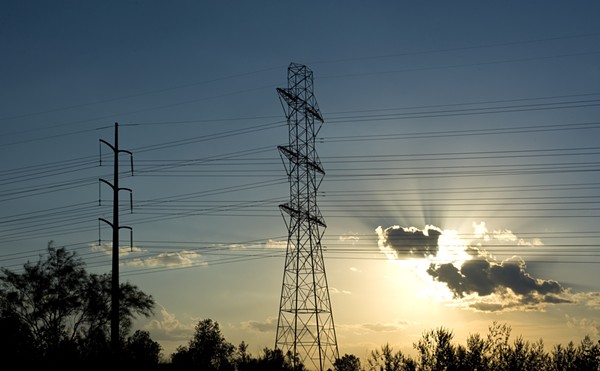Eagle Ford flares at night from NASA's Suomi satellite. Photo screen shot from AACOG report.
The report, conducted by Alamo Area Council of Governments (AACOG) in coordination and with financial support from state funds through the Texas Commission on Environmental Quality (TCEQ), predicts emissions by Eagle Ford will “increase significantly” in the coming years. While the shale play emitted 101 tons of VOCs (volatile organic compounds) per ozone season day in 2011, research estimates that number will balloon anywhere from 338 tons to 872 tons per ozone season day by 2018.
According to the EPA, health effects of VOCs—emitted gasses comprised of a variety of chemicals, such as benzene—vary, ranging from throat irritation and nausea to liver, kidney and central nervous system damage. Exposure to some organics is “suspected or known to cause cancer in humans.”
Nitrogen oxide levels, which can contribute to air pollution and create ground level ozone when mixed with VOCs and sunlight, are similarly estimated to rise from 66 tons to 146 to 188 tons per peak ozone season day.
Contributing to the increase in pollutants, oil and gas production is set to jump drastically— the number of wells drilled within the 20,000-square-mile Eagle Ford area could quadruple, reaching 32,000 by 2018. Oil production could rise from more than 360 million 363 barrels per year to more than 760 million.
The emission projections don’t bode well for San Antonio’s worsening air quality, already in jeopardy. In violation of federal air quality standards since 2012, SA is on the cusp of falling into non-attainment status under the Clean Air Act when new EPA guidelines are released next year.
A February report, “Big Oil, Bad Air,” from Inside Climate News, the Center for Public Integrity and The Weather Channel, explored the threat of air pollution emitted from the shale industry, profiling the health complications incurred by families living near the Eagle Ford Shale, also profiled by the Current. It additionally took aim at Texas’ lax governmental regulation when it comes to fracking, pointing to faulty air monitoring systems and little rebuke from regulatory agencies when oil companies violate standards.
A report by environmental group Earthworks issued in September also criticized regulators—like TCEQ (who helped fund the recent AACOG report) for lack of accountability, as the Current previously reported. Researchers, who undertook their own air pollution testing, concluded fracking the Eagle Ford Shale threatens the health and safety of residents in the area.
It might be worth keeping an eye out for any censure about the latest report from TCEQ; the state regulators penalized AACOG for making a similar report public last summer by freezing funding for the San Antonio metro area coalition’s air quality improvement work after an AACOG official shared results suggesting fracking helped cause pollution in the city.



















